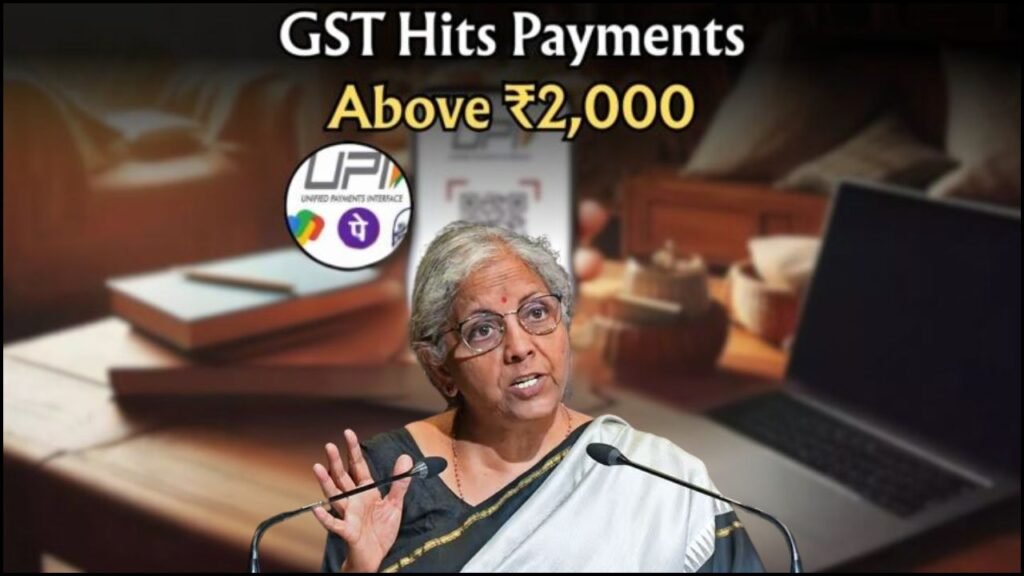
India’s digital payment landscape may be on the verge of a major shakeup. The central government is reportedly considering a proposal to levy Goods and Services Tax (GST) on UPI (Unified Payments Interface) transactions that exceed ₹2,000. As one of the most commonly used payment modes in India, UPI has become integral to everyday life—be it for groceries, rent, or business deals. So, naturally, this potential change is raising eyebrows and questions alike.
If implemented, this rule could affect millions of users, especially small merchants, freelancers, and middle-class households. Let’s break down what this proposed rule means for you and how it might impact your day-to-day transactions.
What Is the New UPI GST Rule?
The government is currently exploring the idea of applying an 18% GST on UPI payments that exceed ₹2,000 in a single transaction. The key objective is to bring high-value digital transactions under the formal tax net and improve transparency in financial dealings.
Here’s a quick overview:
- Threshold: Transactions above ₹2,000 may attract GST
- Scope: Could apply to both peer-to-peer (P2P) and business transactions
- Rate: Likely set at 18%
- Platforms Involved: Google Pay, PhonePe, Paytm, BHIM, etc.
- Implementation Date: Yet to be officially announced
Why Is GST Being Considered for UPI Transactions?
As UPI usage skyrockets in India, the government has taken note of the growing number of high-value transactions that remain outside the GST framework. According to officials, this move aims to:
- Boost GST revenues by tapping into digital payments
- Prevent tax evasion on large, unrecorded digital transactions
- Ensure better transparency in business payments
- Encourage formalization of the growing digital economy
This proposal is not about taxing everyday users but about ensuring compliance where large sums are exchanged frequently—especially for business purposes.
Key Features of the Proposed Rule
If rolled out, the new GST rule will introduce several changes to how we use UPI:
- Threshold Limit: Only payments over ₹2,000 will attract GST
- Scope of Application: Likely focused on merchant and business payments
- Personal Transfers: Family or friend-to-friend P2P transfers may remain tax-free
- Platform Fees: Apps may pass on GST charges to the user
- Compliance: Businesses accepting UPI payments may need to update billing systems
Impact on Daily Users and Small Businesses
The new guideline has different implications for different user groups. Let’s look at what it could mean for you:
For Individuals
- Daily UPI usage for groceries, food, and e-commerce may become slightly costlier
- Users may start breaking large payments into smaller parts to avoid the ₹2,000 limit
- Increased awareness will be essential to avoid unexpected charges
For Small Merchants
- Frequent high-value UPI payments will now need to be GST-compliant
- Those without GST registration may face compliance challenges
- May lead to minor price hikes to absorb the added tax
How GST Could Be Charged on UPI Transactions
To understand the real-world effect, here’s a quick table illustrating how GST might apply on various UPI payments:
| Transaction Amount | GST Rate | GST Amount | Total Cost for Payer | Notes |
|---|---|---|---|---|
| ₹2,500 | 18% | ₹450 | ₹2,950 | Standard 18% GST applied |
| ₹3,000 | 18% | ₹540 | ₹3,540 | Total amount includes GST |
| ₹1,999 | 0% | ₹0 | ₹1,999 | Below the GST threshold |
| ₹5,000 | 18% | ₹900 | ₹5,900 | Higher impact on large transactions |
| ₹2,001 | 18% | ₹360.18 | ₹2,361.18 | Even ₹1 over limit gets taxed |
| ₹10,000 | 18% | ₹1,800 | ₹11,800 | Major impact for businesses |
| ₹1,000 | 0% | ₹0 | ₹1,000 | No tax below limit |
Possible Exemptions and Clarifications Expected
While the rule is under consideration, several exemptions are also being discussed:
- Personal Transfers: Transactions between friends and family might be excluded
- Government Services: Payments like electricity bills and tax payments may be exempt
- Essential Needs: Transactions for medicine, education, or rations could be spared
- Rural Users: Special consideration for rural UPI users to avoid financial strain
These clarifications are essential to ensure the rule doesn’t discourage the digital economy, especially in sensitive sectors.
Government’s Clarification and Timeline
So far, there’s no official notification or implementation date. However, the Finance Ministry and GST Council are expected to issue a public statement soon. This will likely cover:
- Whether the rule will impact individuals or just businesses
- The final GST rate for UPI transactions
- Rollout timeline and software updates on UPI platforms
- Clarity on exemptions and billing protocols
What Should You Do as a User?
While we wait for official confirmation, here are some smart steps to take now:
- Track Transaction Values: Try to keep UPI payments below ₹2,000
- Stay Informed: Follow updates from UPI platforms and government portals
- Split Payments: Consider dividing large purchases into smaller payments
- Check for Charges: Look at the payment breakdown before confirming
- Seek Help: Small vendors should consult tax professionals for advice
Likely Impact Based on User Category
| User Category | Current Scenario | Post-GST Rule Impact | Suggested Action |
|---|---|---|---|
| Daily User | No GST on UPI | May face 18% GST on large payments | Use cash or card for bigger spends |
| Small Business | Accepts UPI freely | May require GST registration | Shift to POS or alternative digital methods |
| Freelancers | Gets paid via UPI | Net payout may reduce due to GST | Prefer bank transfers |
| Students | Pay rent or fees via UPI | Might exceed threshold | Confirm with landlord if exempt |
| E-Commerce Seller | Receives UPI payments | GST on every high-value order | Adjust pricing and issue GST invoices |
| NGOs | Receive donations via UPI | Unclear if exempt | Await official update |
| Government Employees | Use UPI for personal transactions | Depends on transaction value | Stay updated with circulars |
Final Thoughts
The proposed GST on UPI transactions over ₹2,000 could be a significant step in formalizing India’s booming digital payment ecosystem. While the intent is to boost tax compliance and transparency, the rule might also lead to increased financial burden for users and small businesses.
As we await further details from the government, it’s best to stay informed and adapt your transaction habits accordingly. Whether this rule marks a minor speed bump or a major change in how India pays—only time will tell.
Note: This article is based on preliminary reports and ongoing discussions. Final decisions will depend on official notifications from the Government of India, the GST Council, and the RBI. Please consult with your tax advisor before making any financial changes

Mangesh Garg is a passionate writer known for captivating stories that blend imagination and reality. Inspired by travel, history, and everyday moments, He crafts narratives that resonate deeply with readers



